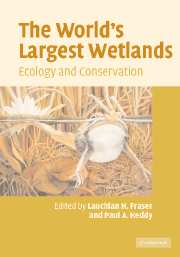Book contents
- Frontmatter
- Contents
- List of contributors
- Preface
- 1 Introduction: big is beautiful
- 2 The West Siberian Lowland
- 3 The Amazon River basin
- 4 The Hudson Bay Lowland
- 5 The Congo River basin
- 6 The Mackenzie River basin
- 7 The Pantanal
- 8 The Mississippi River alluvial plain
- 9 The Lake Chad basin
- 10 The River Nile basin
- 11 The prairie potholes of North America
- 12 The Magellanic moorland
- 13 The future of large wetlands: a global perspective
- Index
- References
5 - The Congo River basin
Published online by Cambridge University Press: 10 August 2009
- Frontmatter
- Contents
- List of contributors
- Preface
- 1 Introduction: big is beautiful
- 2 The West Siberian Lowland
- 3 The Amazon River basin
- 4 The Hudson Bay Lowland
- 5 The Congo River basin
- 6 The Mackenzie River basin
- 7 The Pantanal
- 8 The Mississippi River alluvial plain
- 9 The Lake Chad basin
- 10 The River Nile basin
- 11 The prairie potholes of North America
- 12 The Magellanic moorland
- 13 The future of large wetlands: a global perspective
- Index
- References
Summary
The Congo River has the second greatest discharge of any river in the world after the Amazon. It drains 3.7 million km2 of the African continent. Through its middle course from Boyoma Falls near Kisangani to Malebo Pool at Kinshasa/Brazzaville, the river drops only 115 m over 1740 km as it crosses the cuvette centrale congolaise, a vast, shallow depression along the equator in the heart of Africa (Hughes & Hughes 1992). Throughout the cuvette centrale, great swamps extend behind the river's levees and along the banks of the numerous tributaries that drain it (Fig. 5.1). These swamps and other wetlands are estimated to cover at least 69 000 km2 in the Congo and 120 000 km2 in the Democratic Republic of Congo (D. R. Congo, formerly Zaire; Hughes & Hughes 1992), for a total of c. 190 000 km. To put these swamps in perspective, they are larger than the states of Louisiana and Mississippi put together or over four times the size of Switzerland. This makes them the fourth- to fifth-largest area of wetlands in the world.
In contrast with their striking size, these swamps are poorly studied and understood. Older reviews of African wetland ecology hardly mention them (Thompson & Hamilton 1983, Denny 1985). Most of the primary research on the swamps themselves dates from the colonial era and is found in obscure publications in France and Belgium.
- Type
- Chapter
- Information
- The World's Largest WetlandsEcology and Conservation, pp. 149 - 165Publisher: Cambridge University PressPrint publication year: 2005
References
- 3
- Cited by



